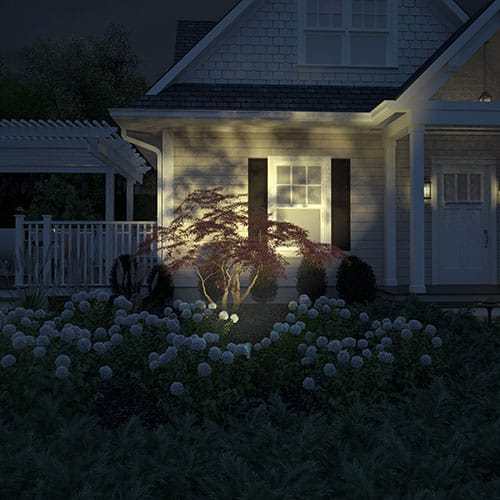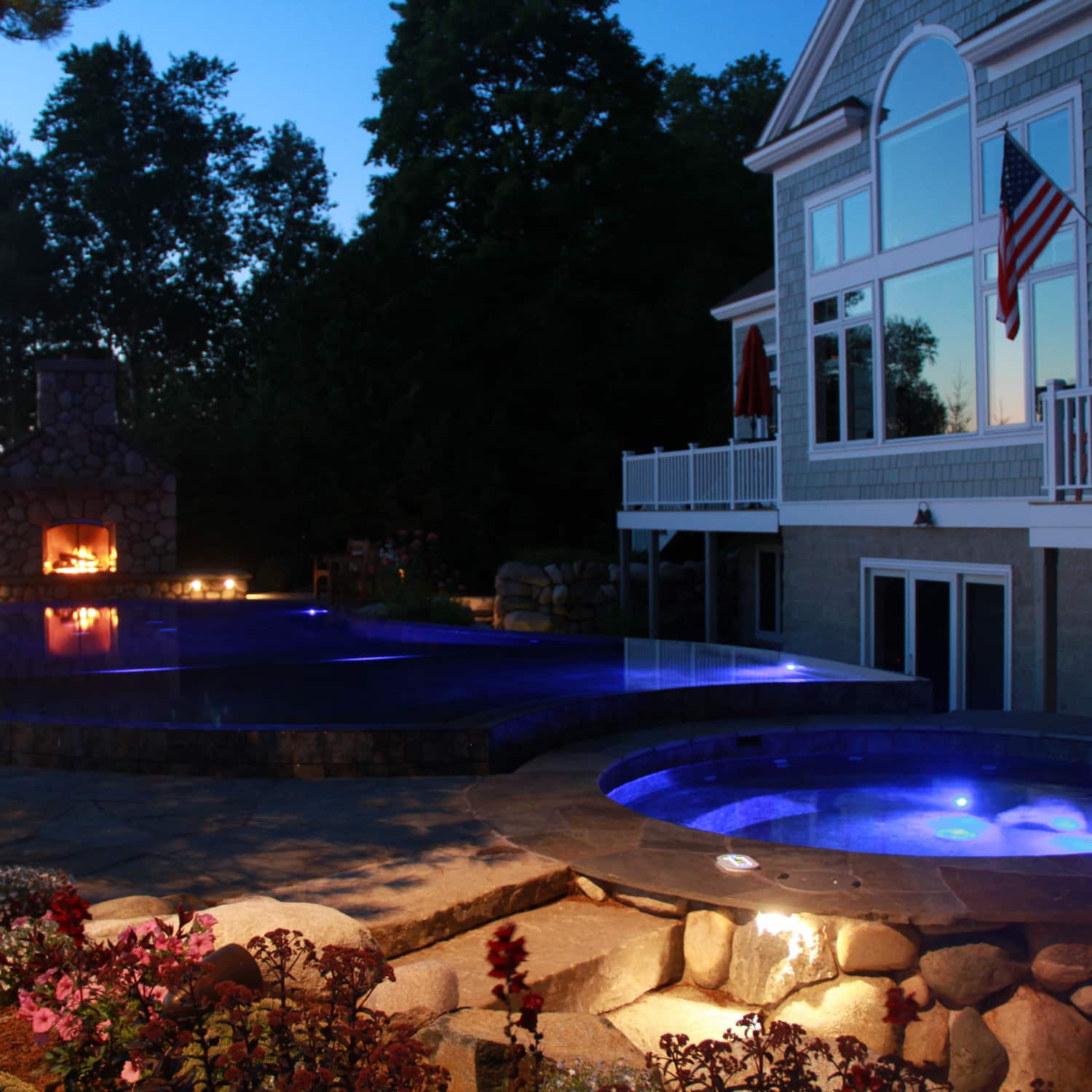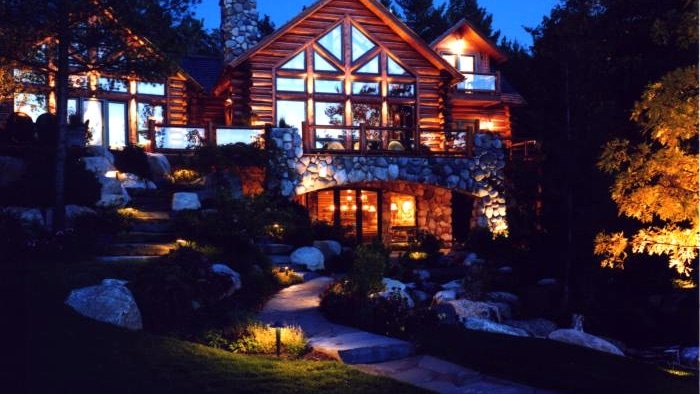Landscape lighting placement varies depending on the techniques utilized.
- Highlighting – at the base of an outdoor feature
- Silhouetting – behind the feature, towards a close wall
- Shadowing – at the base of feature towards a wall
- Washing – a few feet away at an indirect angle to a wall or shrubs
- Up-lighting – low at the base light like washing, but more direct
- Down-lighting – bright and fixed in an eave, trellis, or hardscape
- Moonlighting – soft large fixture(s) high in tree angled down
- Accenting – angled up or down with a narrow beam from a hidden position
- Path-lighting – often staggered, illuminate the entire path, especially steps and obstacles
- In-grade – installed in surface, often at the base of stone wall or hardscape for shadow
- Pool/shoreline – less than 12” submerged near steps, or above, utilizing end or spaced placement
Let’s explore each technique a little bit more.
Highlighting
Provide shape, color, and form using this style of landscape lighting. Start by placing your spotlight(s) at the base of what you would like to feature – a garden trellis, statue, a portion of your house or water feature are a few examples. Vary the distance and angle to achieve the desired highlight effect. The closer the light is, the more precise the area highlighted. Change the colors of the bulbs for a festive or seasonal look of your home, retaining wall, fence or garden.

Photo courtesy of Hunter Industries Incorporated.
Silhouetting
Create a dramatic effect at night in your landscape with silhouette lighting. Begin by placing a spotlight behind the landscape feature, aiming it at a wall or fence behind the feature. The object will be silhouetted against a soft light background. Multiple fixtures may be necessary, depending on the amount of lighted surface area needed to effectively silhouette the landscape feature. Some of the most striking execution of silhouetting uses dense subjects like planters, well-manicured evergreen shrubs, and arbored trees with dense foliage.

Photo courtesy of VOLT® Lighting
Shadowing
Washing a feature with soft light, and illuminating the background surface casts an often magical set of shadows to appear on walls or the facade of a building. Low lighting angled up creates a grand shadow bigger than the original.
Consider playing with the distances and angles, as well as incorporating plants that provide movement in the breeze, like ornamental grasses.

Photo courtesy of The L.D. Kichler Co.
Washing
Washing is a technique that is most commonly applied to walls and rows of shrubs. This technique utilizes an indirect angle of light that creates a soft, almost ambient glow.
For best results, a wide-angle flood light with low wattage is preferred over a spotlight. Experimenting with height and angle is also recommended to find the perfect light.

Photo courtesy of Hunter Industries Incorporated.
Up-lighting
A variety of fixtures are appropriate for up-lighting depending on the subject being lit. Essentially, this is light from below that can shadow, wash or silhouette.
This technique is great for featuring objects, or creating a contrast of shadow and light for varying depths of a structure’s wall, creating a stately and majestic appearance.

Photo courtesy of CAST Lighting
Down-lighting
Attach lighting to a tree or a structure like a wall or building and aim the light down. Depending on what the light is attached to, the results may vary. While With fixtures that are attached to a home, under the eaves, for example, tend to highlight the structure of the house.
Down-lighting creates a directly illuminated area at the base of the structure the fixture is attached to.

Photo courtesy of VOLT® Lighting
Moonlighting
True to its name, moonlighting creates a glow similar to moonlight. Moonlighting is created by placing light fixtures high inside the foliage of a tree, angled down.
The lighting within a tree’s branches and foliage make interesting shadows on the ground, as well as a soft glow from within.

Photo courtesy of CAST Lighting
Accenting
Use this technique to draw attention to a featured object such as a statue. Accenting uses up-lighting or down-lighting to emphasize the object, creating a unique contrast of shadows.
One key to this technique is to utilize a narrow beam of light from a hidden fixture, keeping all of the focus on the object itself.

Photo courtesy of Hunter Industries Incorporated.
Path-lighting
Just because you want your paths safely navigable, doesn’t mean you can’t guide them with a sense of romance or intriguing adventure.
When placing fixtures along a walkway or path, consider risks like being kicked or struck by a mower, and be sure they are angled down to avoid glare. A variety of down-lighting techniques can be used when lighting a path.

Photo courtesy of Hunter Industries Incorporated.
In-grade
In-grade lighting is often installed at the base of a stone wall or other hardscape feature.
These fixtures (usually well lights) are often installed flush with the surface. This technique is best applied where other fixtures might create a tripping hazard or unwanted obstacle.

Photo courtesy of Hunter Industries Incorporated.
Pools, Spas, Shoreline, Fountains, and Ponds
Water lighting can be installed both above and below the surface. To properly illuminate underwater stairs in a spa or pool, fixtures in that area should be no more than 12 inches below the surface.
In general, fixtures placed at either end or spaced along the side wall are the most practical location – taking into consideration coverage for curves. Moving water can be especially striking when it is illuminated from below, showcasing the movement of the water on the surface. This style of lighting should be done by a licensed professional for safety.

Drost Landscape Lighting
At Drost, we know the right heights, distances, and composition of using these techniques to create the most strikingly remarkable landscapes at night. Our team of lighting professionals also install seasonal lighting, in cooperation with our tree service division, for a festive look or special occasion. Give the northern Michigan landscape lighting company with all the design, installation and maintenance experience a call today! (231) 348-2624



